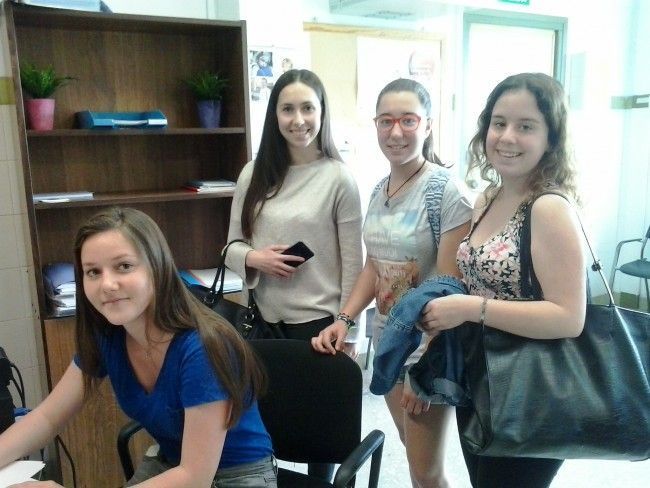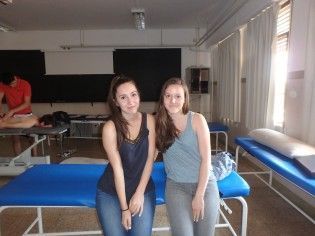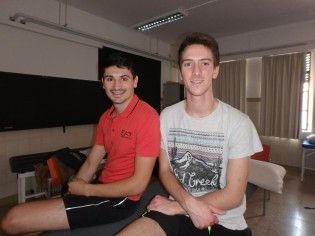This week we accompanied a group of students from the Physiotherapy Degree at our university, in the preparations for their project on “Massage therapy”. Silvia Cascos, Marta Ferrando, Manon Contente and Célia Vallier are first-year students and undoubtedly, they will face this type of work with a little uncertainty.
 Before going on to the subject, we are going to get to know our students a bit better:
Before going on to the subject, we are going to get to know our students a bit better:
Silvia tells us that she has always liked this course, especially childcare, as well as ballet practice and these two disciplines complement each other perfectly: sport and physiotherapy, once again. Her sister is a nurse and when she took her to the hospital, she kept observing how the physiotherapists worked. She knows that she will specialise in neurorehabilitation of neonates. The subject that she likes the least is physics, as it is hard for her to do the anatomy practices, but for the rest she only has good things to say. She enjoys studying in our university.
Marta, just like Silvia, enjoys working with children; she would like to specialise in the field of disability and infancy (we encourage her to follow this amazing path – she needs to!); Marta recognises that in the area of Alicante there is a high demand and very low offer in this field. She doesn’t enjoy the physics class either but she enjoys the dissection class more than her classmate. She is very happy with the decision to study physiotherapy and with the content of the degree in the university, the practices have a very high value for them all and they have every type (it makes us happy to know that the path we follow on the course is the right one). Marta also likes sport and in her free time we can find her playing handball.
 Manon is a French student who is very well integrated with her peers. This requires an effort but it is worth it as the reward is very beneficial. On weekends they go out together, when their studies and free time allow it. Manon practises pole dancing, and she would like to specialise in more general physiotherapy, or maybe in sports discipline. She really likes Valencia.
Manon is a French student who is very well integrated with her peers. This requires an effort but it is worth it as the reward is very beneficial. On weekends they go out together, when their studies and free time allow it. Manon practises pole dancing, and she would like to specialise in more general physiotherapy, or maybe in sports discipline. She really likes Valencia.
Célia comes from Grenoble (Southeast France). At the start it was hard for her to face a life outside of her environment but now (she tells us with a smile on her face) she loves this experience. “The climate is great and I especially enjoy the river Turia park”. “The number of practicals that we have is really interesting for me; they allow us to know all the muscles in a very thorough way. I would like to specialise in Osteopathy”.
We cannot forget that leaving your city and arriving at an unknown country and handling yourself with a new language is an important limitation. They felt worried at the start of the year but they did not delay in valuing everything that Valencia offers them and they could not be happier: the climate, the beach, the people, the new friends…
With regard to the work topic of Massage therapy, we can tell you how they organise themselves, if they have a preliminary project…
Once your professor gives you the task in class, what is the next step? How much time do you use?
Once the group is formed, we get to work. They give us three weeks to carry it out, but we cannot start writing about it until we finish the last practice, so really about a month.
Are you afraid of the unknown?
It is the first project for this subject and it is a bit imposing; this project is worth a mark in the final grade so it is important to achieve it.
Do all of your peers have similar ideas? Does one always work more than another?
That usually happens in the best families, we try to balance the work equally. It is necessary to be equal classmates.
Can you be creative or are they closed projects?
It hasn’t occurred to us to ask that but as it is a practices book, we don’t think that a lot can be innovated. We can search for a differentiating value with the photographs. We can publish six pages for each practice, which will make a total of 26 pages.
Do you look for advice from students in other years with more experience?
We haven’t thought about that either.
 Their classmates, Aymerich and Louis, tell them that they must not forget basic topics: use of oils, the correct position of the hands at the time of applying the therapy, the figure of the patient, the goniometer, measuring the degrees of movement…basically, that it is a relatively easy job and they should be calm.
Their classmates, Aymerich and Louis, tell them that they must not forget basic topics: use of oils, the correct position of the hands at the time of applying the therapy, the figure of the patient, the goniometer, measuring the degrees of movement…basically, that it is a relatively easy job and they should be calm.
Thank you for your advice, we hope that the example goes a long way and the older students help the new arrivals with their practices.
We can summarise their work schedule in four steps:
1. Choosing the classroom and reserving it in the Dean’s office: getting authorisation to make use of a practice room.
2. Divide the practice up for each one and prepare the written part.
3. Make photos in the group.
4. Layout and presentation of the project.
So all of our readers can follow us, we shall leave you a brief note about Massage therapy:
There are two types of massage, aesthetic and therapeutic. The latter is what is taught in the practices of the General Rules of Physiotherapy I and the motive of the book that the students have to put together.
In the 19th Century, “Massage therapists” were referred to as the people in charge of the rehabilitation of injuries on the body. You could say that the massage techniques for therapeutic reasons form one of the pillars that support physiotherapy nowadays.
Their professor, Javier Montañez, tells us that this project is proposed as a revision to strengthen the knowledge acquired in the subject throughout the year; with this aim, including the photos that must be taken on therapy and patients, must be made outside of the practice classes that happen throughout the degree.








